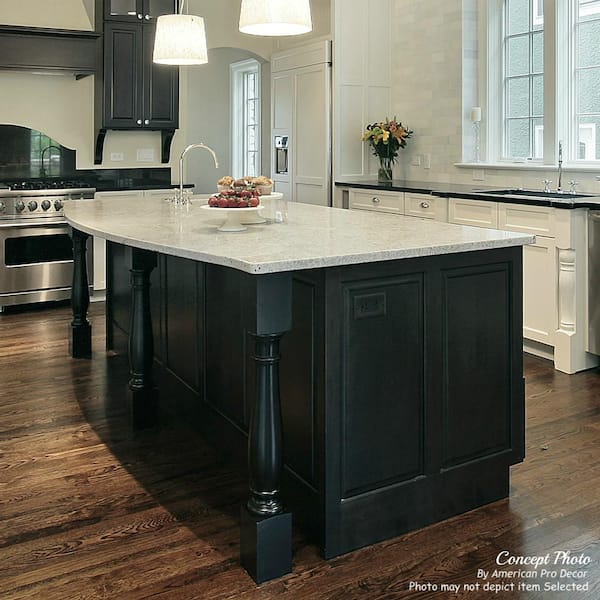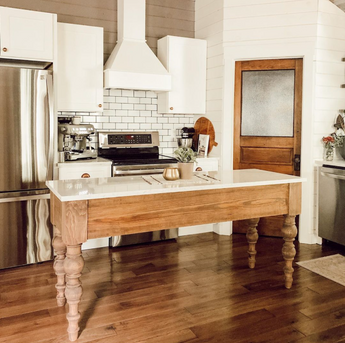Premium Kitchen Island Legs for a Sturdy Island Base
Wiki Article
Crucial Tips for Picking the Perfect Dining Table for Your Kitchen
Picking the excellent table for your kitchen is greater than just a matter of preference; it demands a complete understanding of your room and requirements. Begin by measuring your readily available room to guarantee adequate clearance for activity. The shape of the table plays a critical function; while rectangle-shaped tables fit bigger areas, rounded ones foster affection, and extendable alternatives supply flexibility. Material option is equally critical, with woods offering toughness and glass borrowing a modern-day touch. The table must harmonize with your kitchen area's aesthetic appeals and suit your family easily. What other aspects might influence this essential choice?Action Your Room
Picking the ideal dining table starts with a precise assessment of your readily available area. This fundamental step guarantees that the table not just fits conveniently within the area yet also enhances the general layout and performance of your eating location.Take into consideration the flow of activity around the table. It is important to leave adequate room for chairs to be taken out and for individuals to relocate around the table without blockage. A general policy of thumb is to enable at the very least 36 inches of clearance from the edge of the table to the closest wall or piece of furnishings. This guarantees convenience of gain access to and comfort throughout dishes.
Additionally, think of the number of individuals you normally amuse and whether you require extra space for guests. Deciding for an extendable table can provide flexibility, permitting you to accommodate differing varieties of diners. By properly gauging your space, you prepared for choosing an eating table that boosts both the aesthetics and capability of your dining location.
Select the Right Shape

On the other hand, round tables are exceptional for smaller sized kitchens or intimate events, as they advertise conversation by enabling every person to face each other. They likewise supply a feeling of coziness and can fit well in tighter areas as a result of their absence of sharp corners. Oval tables use the most effective of both worlds, integrating the size of rectangle-shaped tables with the affection of round ones, making them versatile for different setups.
Square tables are another alternative, specifically matched for square-shaped areas. They develop a balanced and contemporary look, fostering an equal eating experience for all seated.
Product Factors To Consider
When choosing a table, material factors to consider are vital in figuring out the table's longevity, upkeep requirements, and general aesthetic. Timber is a timeless option, providing timeless allure and toughness. Hardwoods like oak, mahogany, and walnut are particularly sturdy, though they can be expensive. kitchen island legs. Softwoods, such as yearn, are more economical but might be susceptible to scratches and damages.Glass-topped tables offer a modern-day, smooth appearance and can make a space show up larger as a result of their transparency. Nonetheless, they require constant cleaning to protect against fingerprints and spots. Furthermore, toughened up glass is recommended for its extra strength and safety and security.

Finally, composite materials like MDF (Medium-Density Fiber board) or plywood are affordable alternatives. These products can simulate the appearance of strong wood yet may not offer the very same long life. They are normally simpler to tidy however can be susceptible to water damages if not effectively sealed.
Inevitably, the option of material must align with your cooking area's style, your lifestyle requires, and your budget plan restrictions. (kitchen island legs)
Seating Ability and Convenience
How do you determine the best seating ability and comfort for your table? This essential action involves examining both the physical space offered in your cooking area and your home's useful needs. Begin by determining your kitchen location to ensure the table fits easily, allowing at the very least 36 inches straight from the source of clearance around it for very easy movement. Think about the variety of individuals who commonly dine with each other, as this will certainly influence the table size. For a family members of four, a rectangle-shaped table of 48 inches long or a round table with a 48-inch size is usually sufficient.Comfort is equally necessary. The elevation of the table need to ideally be around 30 inches, offering a balanced ergonomic stance for seated diners. Chairs must sit elevation of 18 to 20 inches to make certain a comfy eating stance. Additionally, consider the chair design; upholstered seats and helpful backrests can improve eating convenience dramatically, especially throughout long term dishes.
Style and Appearance
Picking an eating table that fits your style and aesthetic appeal includes balancing individual preference with the existing decoration of your dining space. The table is often the focal point of the cooking area, and its style must complement the overall motif of the space. Whether your kitchen area boasts a modern-day, minimal look or a rustic, farmhouse beauty, the table you pick ought to harmonize with these components to produce a cohesive and welcoming atmosphere.Consider products very carefully; wood supplies an ageless appeal and can vary from rich mahogany for a typical aim to lighter oak for a contemporary feeling. Metal and glass tables, on the various other hand, can introduce a streamlined, commercial edge to your kitchen. Do not overlook the table's form-- rectangular tables are functional and classic, while round and oblong choices can cultivate a much more intimate dining experience.
Furthermore, pay attention to details and coatings. A distressed coating might include character and warmth, whereas a shiny surface can add to a clean, modern-day aesthetic. Eventually, your dining table must not just fit flawlessly into your cooking area's style yet also show your individual style, raising the room both functionally and visually.
Final Thought
In conclusion, picking the optimal table for a kitchen area necessitates cautious evaluation of area, form, material, seating capacity, and visual consistency. Guaranteeing a minimal clearance of 36 inches facilitates comfortable motion, while the selection of shape enhances spatial dynamics. Material choice influences resilience and style, making it important to straighten with the cooking area's overall aesthetic. Ultimately, a well-chosen table promotes a welcoming environment and suits the house pleasantly, thus enhancing the dining experience.
When choosing a dining table, product More Help factors to consider are paramount in identifying the table's durability, maintenance requirements, and general visual. For a family members of 4, a rectangular table of 48 inches long or a round table with a 48-inch diameter is typically adequate.
Do not forget the table's form-- rectangle-shaped tables are versatile and classic, while round and oval choices can promote a much more intimate dining experience. kitchen island legs.
Report this wiki page